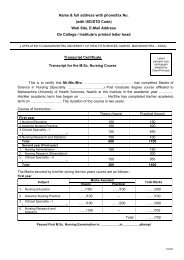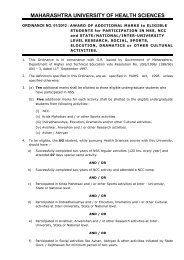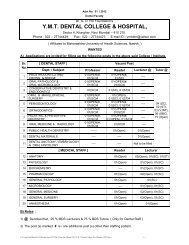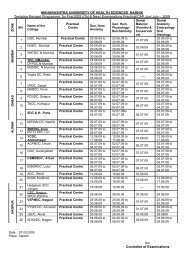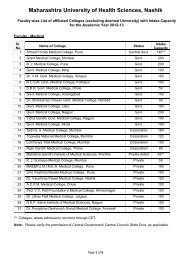Unit I
Unit I
Unit I
You also want an ePaper? Increase the reach of your titles
YUMPU automatically turns print PDFs into web optimized ePapers that Google loves.
11. Exocrine GlandsGeneral Consideration: The epithelial tissue is divided into the covering or the lining membrane and the glands.The glands are specialised epithelial tissues suitably modified to produce some secretion. The secretory cells arepresent singly or in groups and thus constitute the unicellular or multicellular glands. Unicellular glands areinterspersed among other nonsecretory epithelial cells. They are called the glands because of the shape like anacorn (L - gland = acorn).Multicellular glands develop as a diverticulum from the epithelial surface. The distal partof the diverticulum forms the secretory element. The proximal part either disappears or forms a duct.Exocrine (Acinus and duct):These are the glands which pour their secretion onto the epithelial surface (milieuexterior) through the ducts (Gr - Exo = out). It shows terminal secretory unit having columnar cells and centrallumen, which continues with a small duct.Endocrine (Cell and capillary): These glands pour their secretion into the adjacent capillaries (milieu interior). Theyare ductless glands (Gr. Endo = Inside) and the secretion is hormone. It shows a group of cells placed around thecapillaries. Except in the thyroid, extra cytoplasmic storage of hormone is not seen.Paracrine: The secretion is neither released into blood nor into the duct but it is released locally. It is swift andlocalized in the induction of response. The secretion can act on the contiguous cells or on groups of nearby cellsbrought by diffusion.Autocrine: Secretion acts on the cell which secretes.Juxtacrine: Secretion acts on the immediate adjacent cell.Morphological classification of exocrine glands:The exocrine glands have two basic parts: a secretory unitand a duct. If the secretory unit is elongated in shape, it is called a tubular gland. If the secretory unit is like a bunchof grapes or flask- shaped, it is called acinar or alveolar. The classification is based on whether duct is branched ornot, and on whether the secretory unit is branched or not. If the duct is not branched, the prefix ‘simple’ is used. Ifthe duct system is a branched one, then the prefix compound is used. The secretory unit ‘tubular’ may be branchedor not branched. The secretory unit ‘acinar’ may be branched or not branched. Accordingly the exocrine glandscan be classified as:Simple tubular gland: Duct is not branched; the tubular secretory unit is not branched. (eg) Mucosal glands oflarge intestine.Simple coiled tubular gland: Duct is not branched; the tubular secretory unit is coiled. (eg) Sweat glands of theskin.Simple branched tubular gland: Duct is not branched; the tubular secretory unit is branched.(eg) Gastric glands.Simple acinar gland: Duct is not branched and the secretory unit acinar shaped and not branched.(eg) Mucosalglands of penile urethra (urethral glands of Littre).Simple branched acinar gland: Duct is not branched but the acinar secretory unit is branched. (eg) Sebaceousglands.Compound tubular gland: Duct system is branched and the tubular secretory unit is also branched.(eg)Brunner’s glands of duodenum.Compound acinar gland: Duct is branched and the acinar secretory unit is also branched. (eg)Exocrine glandsof pancreas.Compound tubuloalveolar gland: Duct system is branched and the secretory units are branched and partlyacinar and partly tubular. (eg) Salivary glands.Classification according to the mode of secretion: On the basis of the manner in which the secretion of theexocrine gland is poured out, they are classified into 3 groups.Apocrine : There is an accumulation of secretion in the apical or luminal part of the cytoplasm. During its secretionthe apical part of the cytoplasm is lost. However there is no cell death e.g. Apocrine sweat glands (specializedsweat glands of axilla and groin).Holocrine: (Gr - Hols = all). The synthesized secretion accumulates in the cytoplasm so much so that all theorganelles occupy a very small area and the major part of the cell is loaded with the secretory material. When thesecretion is released, cell lysis occurs and the cell no longer exists. There are basal cells in such gland, whichundergo continuous mitosis and replace the lysed cells e.g. Sebaceous gland.Merocrine: It is also called as the eccrine or epicrine. The secretory product is synthesized in a form of themembrane bound vesicles. These vesicles join to the apical cell membrane. When the cell membrane ruptures thecontent of the secretory vesicle is released into the lumen. No cytoplasm is lost during this process e.g. Pancreas.55





